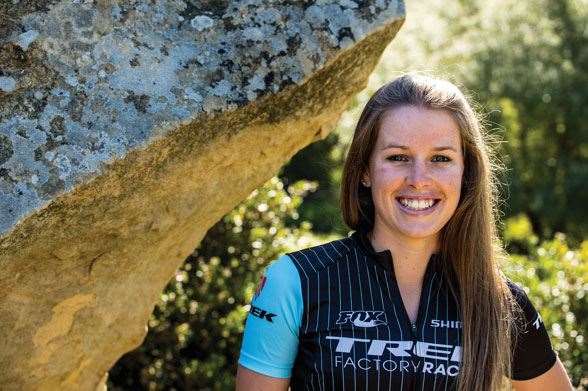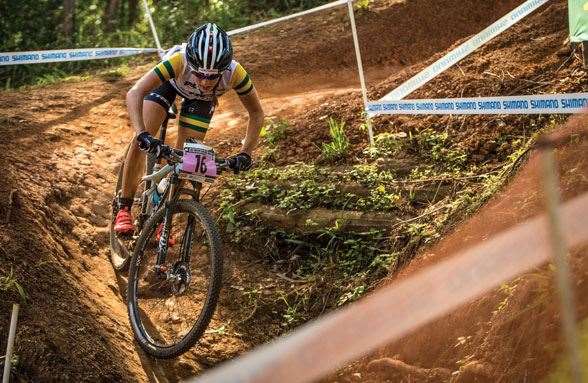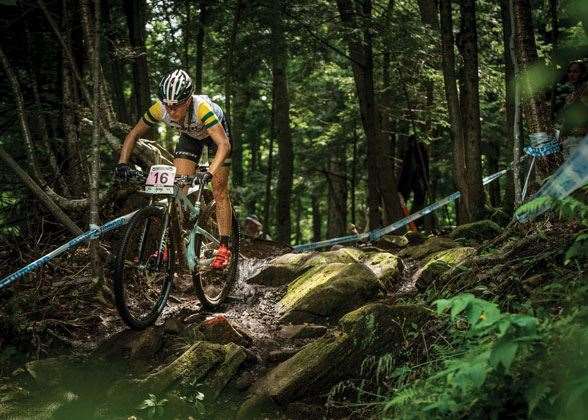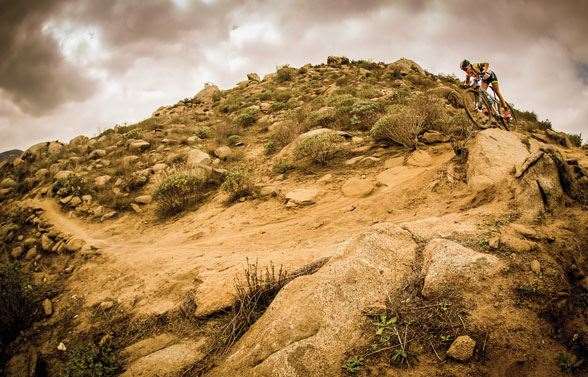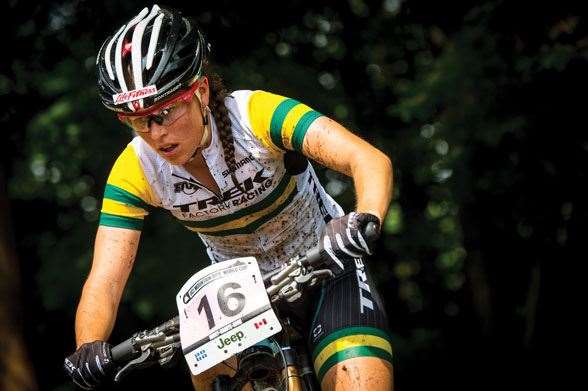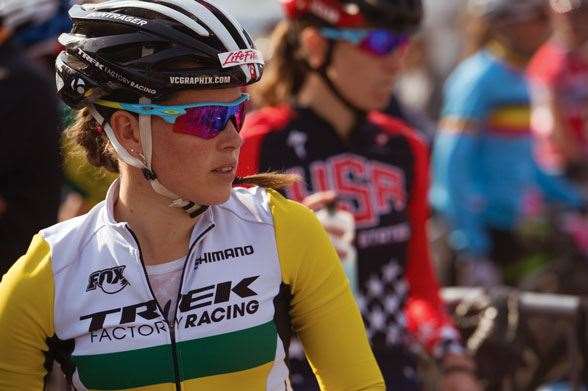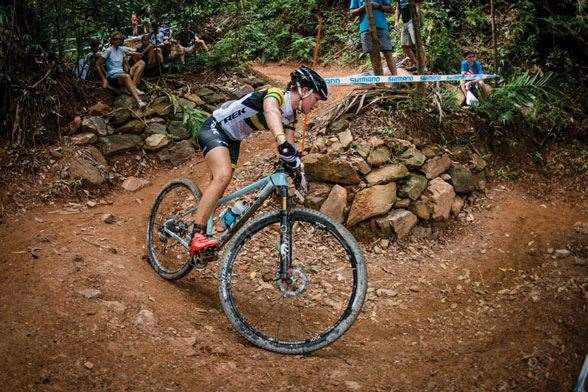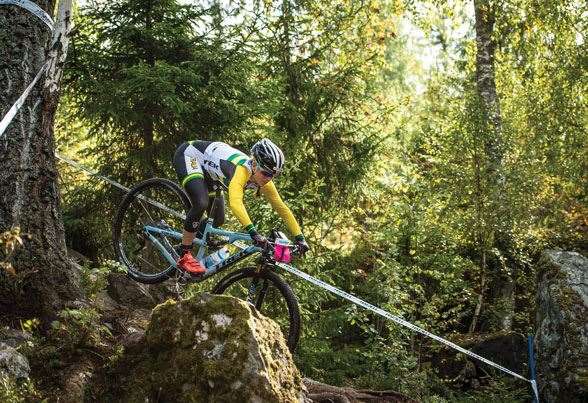Australia's next top mountain-biker has mastered the technical side of XCO.
ONE OF THE BIG shoe brands once attempted to rev up its clientele by adopting the old adage “there is no off-season” as an advertising campaign. Thankfully for Inside Sport, though, in the realm of professional sport, there is an off-season. Sometimes it’s the only window of availability in which we can hold people like Bec Henderson down long enough for a chat, before they’re jetting off again to far-flung corners of the country or to the world’s most exotic locations.
After cooling her jets following an outrageously successful 2014 racing season, Henderson is just now easing herself back into the training schedule that carried her to a mountain bike cross-country bronze at Glasgow 2014. Mountain bike made a spectacular return to the former Empire Games’ list of events at Scotland’s big sports carnival, after first appearing at the Comms in ‘02 and again in 06, before being cut for Delhi. This cycling discipline, though, has in fact been on the Olympic program since the Atlanta Games in 1996. And while we’re on the subject of Games appearances, Henderson was no doubt in safe hands leading up to Glasgow, with her partner ... and coach ... and pro team-mate Dan McConnell obviously in her corner, himself a cross-country mountain bike Aussie rep at Beijing 2008 and London 2012.
The 23-year-old Henderson, of the nation’s capital, who rides full-time for the professional Trek Factory Racing team, also claimed the 2014 Australian National Championship at Bright, Victoria, in March, her greatest result since finishing first overall in the 2013 Under-23 UCI Mountain Bike World Cup series.
We were lucky enough to score a lesson from Henderson about how she stays at the top of her game, how she handles her killer competition schedule ... and what kind of machine cross-country mountain bikers need to maintain pace with the best.
AROUND THE WORLD
“Our racing season in Australia typically begins in December or January. We start in the Australian summer with our domestic racing series and the National Championships, which lead into the US series. There, our team, Trek, competes in a couple of races in March and April. The World Cup series, held predominately in Europe, kicks off in May and runs through till September.
“That’s a standard annual schedule for me. Each year there‘s a bit more travel added on with the addition of a few more races, but the benchmark World Cup season is six-seven races, across Europe and the US and then the World Championships on top of that. Originally I was racing just the European World Cup events, but I eventually decided to compete across the entire international program, including races in America. This year we even had a World Cup leg in Cairns and one in South Africa.”
TO YOUR STRENGTHS
“I grew up riding around the trails with my dad and my brother. I was never super-strong, but I was always quite good on the single trails and at handling technical aspects of courses. This has been my strength which has carried through over the years. I like really steep climbing, but when it comes to total ‘power’ sections, that area is definitely my weakness. I’m still young, though, and I’m getting better.
“Cross-country mountain biking is the Olympic discipline [XCO]. It’s one race, about an hour and 15 minutes to an hour and a half, consisting of between five and seven laps of a course. For the female riders, a benchmark goal is to complete each lap in 17-20 minutes.”
COURSE FOR CONCERN
“We arrive at the event site about a week before each World Cup leg is held, which means I’ll usually have three days of good training on the course. Obviously when you first get there, some aspects of the course can be pretty overwhelming, especially if there are a lot of technical features, like rocks, drops and steep descents. My partner, Dan McConnell, is actually my coach, and also my team-mate at Trek. He is an Australian cross-country mountain biker and competed at both the 2008 and 2012 Olympics. We check out the course together and dial in the lines, always looking for the smoothest and most efficient way through. Once you have it all down, you can start doing race pace intervals, building on your confidence and speed. So by the time the race comes around you’re ready to go.”
HOME SWEET HOME
“At this time of year, usually between now and January, Dan and I spend a lot of time on our local trails doing fun rides and getting our hours up. Our favourite spot is out at Stromlo Forest Park in Canberra where we had the World Championships here in 2009; it’s a really cool mountain bike park which is open to the public. We have a lot of local club racing at Stromlo as well.
“When we go out to the trails, it takes us almost an hour to ride there from our house. We’ll spend an hour or two on the trails; it could be doing intervals, practising skills, doing jumps or drops. It’s a great advantage to have world-class trails and features to train on. Our time clocking up the hours is also sometimes just riding around and enjoying the trails.
“Then there’s interval training, which covers such a broad range of options for us. Interval training could be ten-second sprints, to anything up to 15-min intervals which are lower-power and lower heart-rate but more sustained.”
ABOUT THE BIKE
“I have two options as far as racing bikes are concerned – a hard tail version or a full-suspension. The hard tail has suspension at the front only and the full-suspension has front and rear shocks; it’s ideal for the more technical courses or the really rough and bumpy ones. The hard tail is generally half a kilo to a kilo lighter: there is always a weight vs comfort compromise which you have to make with each race. There are so many unique features surrounding mountain bikes: you’re always having to choose different tyres depending on the courses, even fiddling with the tyre pressure. The special thing that’s happening in mountain bike at the moment is that we’re graduating to electronic gear shifting. It’s going to be released to all the teams in January. It’s big.
“I ride a Trek Superfly or a Trek Superfly full-suspension. At the moment I’m on 29-inch wheels – this has become the new standard for mountain bikes. The bikes most people have ridden over the years have had 26-inch wheels. I definitely have my bike set up super-personalised for how I like it. I love these bikes.”
IN THE GYM
“Because mountain biking is becoming so much more physical and technical, gym is basically an essential part of training for athletes in the sport. We don’t put any muscle bulk on in the gym; all of our work is strength-related. In mountain biking, your power-to-weight ratio is super-important; you’re always trying be as light as possible ... which obviously involves not putting on any muscle weight.
“When I’m training at home in Canberra in the pre-season, or in the lead-up to our international races, I spend two days a week in the gym, mainly doing pilates. I also focus on a lot of upper-body work. All my gym stuff is body-weight-based, so no big machines or anything like that.
“In the gym I don’t do anything with my legs; all that’s done on the bike. I spend a lot of time doing core exercises and also use what is called a TRX. It’s a suspension training tool with two handles hanging from the roof, quite similar to the gymnastics Olympic rings. You can do a lot of upper-body workouts with it, like push-ups etc – it’s all on an unstable base as opposed to performing exercises on the floor. It kind’ve mimics the stress your arms and body are under when you’re out on the bike. We also like to do circuits involving exercises like push-ups, chin-ups, dips; a lot of those are easy to perform when you don’t have access to a gym. We spend a lot of time on the road ‒ they’re exercises we can perform in the hotel room.”
WORKIN’ IT
“At home I’d do approximately 20 hours on the bike per week, depending on the time of year; it varies from 15-30 hours, spending a lot of time on the road. Then in the racing season it’s all on the mountain bikes; higher intensity and less hours.
“The biggest element of mountain biking, aside from obviously the fitness levels required to get up the climbs, is that the courses on the World Cup circuit are very technical and often quite intimidating. I spend a lot of time perfecting my skills, doing drops over bigger jumps and rock gardens. I put a lot of effort into honing my skills, just keeping them sharp and refined. I ride with a bunch of boys, which challenges you a lot and keeps you on your toes.”
THOUGHT FOR FUEL
“I’m not super-calculating with what I eat; obviously it’s common sense and you have to be strict, fuelling your body with the right foods, learning what works for you and what doesn’t. It’s important for mountain bikers to be as lean and light as possible, which means weeding out the cakes and nice foods and saving them for the off-season. I eat my meal three to three and a half hours before the race, which is semolina – similar to porridge. During the race I fuel on energy drinks and gels – my favourite is GU’s products. If I feel like I’m getting sick, I’ll take multi-vitamins, but apart from that, no supplements, only energy gels for training and racing.”
Related Articles

Bec Henderson
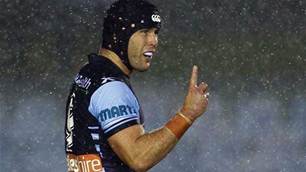
Training with the Cronulla Sharks' Michael Ennis

